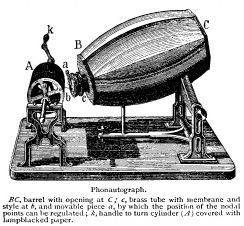

All lovers of vinyl need to check this out. It’s the audio of the earliest known gramophone recording, which is the grandfather of the modern vinyl record. Sure, Thomas Edison had his cylinders in the 1870s, but Emile Berliner invented the flat version of records in 1887. In the prequel to Betamax vs. VHS, or HD-DVD vs. Blu-Ray, Berliner’s gramophone disc dominated the recording industry and Edison’s neat little vertical audio cans remain mostly as footnotes in audio history.
The cool thing about this recording is not that the record itself has survived since 1890, but that it doesn’t actually exist. There are no known physical copies. So how does one hear audio from something that doesn’t exist? The Media Preservation Initiative at Indiana University, Bloomington, had found a way to take the photographs of the physical specimens from reference books and advertisements of the time and recreate the audio from those records. The result is discernible audio recordings of speech, song and a voice memo recorded as a test from the inventor to a friend.
But wait, there’s more.
These are not the first recordings ever made, nor are they the first reproduced sound. Edison’s invention was the first to reproduce the sound audibly. But it was “Au Claire de la Lune,” an 18th Century French folk song, which Édouard-Léon Scott de Martinville sang slowly into a vibrating diaphragm, that changed music forever. The long tube transferred the sound via hog’s bristle and a piece of a feather into waveforms. There was smoke, a rotating barrel and a hand crank involved. Though the phonautograph was a complicated and temperamental device (well, maybe not compared to an iPod in a WiFi-dead zone), audio could now be captured. And in 2011, a mere 151 years later, archivists have found a way to play it back. The recording was made on April 9, 1860 (before the American Civil War)–marking the birth of recorded sound.
Telephones, speakers, microphones–everything we know about audio today–is based on Édouard-Léon Scott de Martinville’s hog’s bristle and feather recording device. From one audio engineer to another, thanks, brother!
.Happy 153rd Birthday, Recorded Sound!












